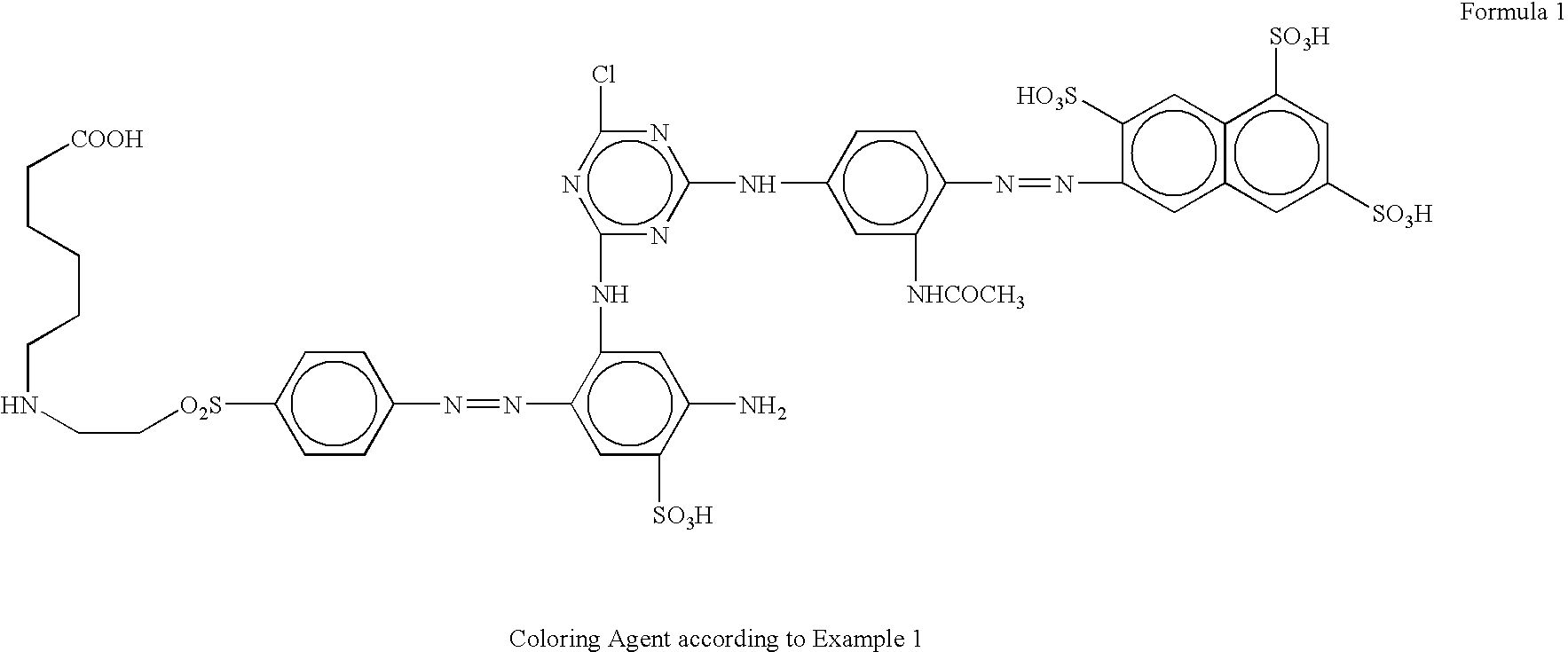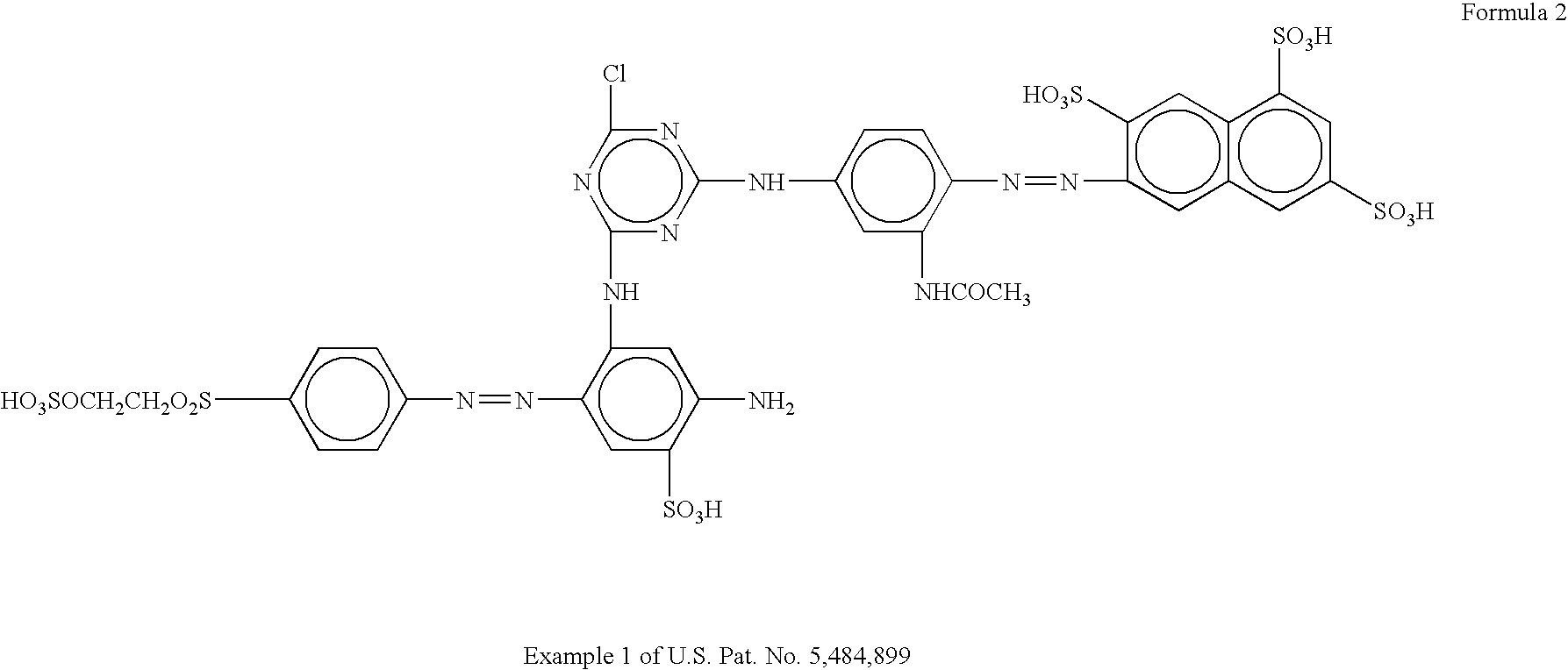New anionic coloring agents to dye leather, paper, cardboard and textile substrates: mixtures of coloring agents including these new products, and substrates dyed using the above coloring agents
a technology of anionic coloring agents and dyeing substrates, which is applied in the field of new anionic coloring agents to dye leather, paper, cardboard and textile substrates, and the combination of coloring agents including these new products, which can solve the problems of high polluting production, limited applications, and inability to meet the requirements of dyeing. high efficiency
- Summary
- Abstract
- Description
- Claims
- Application Information
AI Technical Summary
Problems solved by technology
Method used
Image
Examples
example 1
[0074] 38.3 parts 2-naphthylamine-3,6,8-trisulfonic acid are diazotised as usual, and coupled with 15.2 parts of 3-ureidoaniline previously dissolved in 115 parts of water at 50° C., treated with 30 parts of sodium bicarbonate and ice-cooled at 0-3° C. When the coupling is finished one part of disperser, 140 parts of ice and 19 parts of cyanuric chloride are added, and then stirred for 90 minutes at a pH of 6.5-6.7. Then, the mixture is treated with 18.8 parts of m-phenylendiamine-4-sulfonic acid dissolved in 80 parts of water with sodium hydroxide at a pH of 5.0-7.0, and then ice-cooled at 40° C. The mixture is heated at 35-40° C. and stirred for one hour, maintaining the pH at 6.5-6.7 by adding a 20% solution of sodium carbonate. The monochlorotriazinyl dye obtained, is precipitated by adding a solution of sodium chloride 20% w / v. The dye is filtered and the cake is dissolved in 900 parts of water with sodium hydroxide at pH 7. 28.1 parts of 4-aminophenyl-β-hydroxy-ethylsulphone s...
example 2
[0077] 13.1 parts of ε-aminocaproic acid are dissolved at a pH 10 in 100 ml of water with sodium hydroxide at 48% and are added on 28.1 parts of 4-aminophenyl-β-hydroxy-ethylsulphone sulfate ester previously dissolved in 150 parts of water at pH 7 with sodium bicarbonate. The mixture is heated at 60° C. and stirred for 1 hour. 22 parts of concentrate hydrochloric acid are added. The obtained suspension is cooled at 0° C. with ice and is diazotised with 7 parts of a solution of sodium nitrite 30%. The mixture is stirred for 1 hour at 0-3° C., and then the excess of nitrous acid is eliminated with sulfamic acid, maintaining the temperature within 0-5° C.
[0078] Separately, 31.9 parts of 4-amino-5-hydroxy-2,7-naphthalenedisulfonic acid are dissolved at pH=6.0-6.5 with sodium hydroxide in 100 parts of water, and passed drop-wise on a diazo prepared from 26.3 parts of 4,4′-diaminosulfanilide according to the conventional methods.
[0079] Finished the above copulation, the resulting compou...
example 3
[0082] 31.9 parts of 4-amino-5-hydroxy-2,7-naphthalenedisulfonic acid are dissolved in 100 parts of water at a pH of 6.0 with diluted sodium hydroxide. 24.3 parts of 4-aminophenyl-N,N-dimethylpropilenediamineethylsulfone are suspended in 100 parts of water, 12 parts of 10 N hydrochloric acid are added. The slurry obtained is then ice-cooled at 0° C., and diazotised with 7 parts of sodium nitrite as a 30% solution. It is stirred for one hour at 0-3° C., and the excessive nitrous acid is eliminated with sulfamic acid. At a constant temperature of 0-5° C. the solution of 4-amino-5-hydroxy-2,7-naphthalenedisulfonic acid is added drop-wise on the previous diazo, and stirred for 16 hours. Moreover, 26.3 parts of 4,4′-diaminesulfanilide are diazotised according to conventional methods. The diazo obtained is added rapidly to the previous product after being dissolved with sodium hydroxide diluted at a pH of 6.0-6.5 and ice-cooled at 0-1° C. It is then stirred for 10-15 minutes, and then its...
PUM
| Property | Measurement | Unit |
|---|---|---|
| pH | aaaaa | aaaaa |
| temperature | aaaaa | aaaaa |
| temperature | aaaaa | aaaaa |
Abstract
Description
Claims
Application Information
 Login to View More
Login to View More - R&D
- Intellectual Property
- Life Sciences
- Materials
- Tech Scout
- Unparalleled Data Quality
- Higher Quality Content
- 60% Fewer Hallucinations
Browse by: Latest US Patents, China's latest patents, Technical Efficacy Thesaurus, Application Domain, Technology Topic, Popular Technical Reports.
© 2025 PatSnap. All rights reserved.Legal|Privacy policy|Modern Slavery Act Transparency Statement|Sitemap|About US| Contact US: help@patsnap.com



